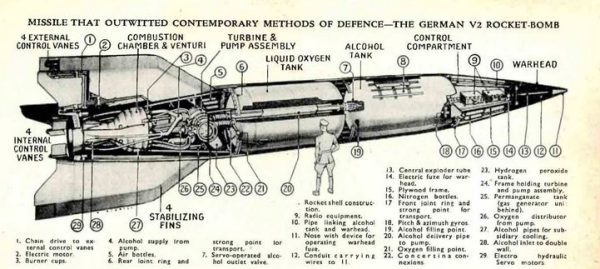The Doodlebug and the Blitz
Children of the Blitz will never forget the V1, or Doodlebug, the fearsome missile that made a curious throbbing, buzzing noise, right up until it reached its target. When the noise stopped, the bomb dropped and the listening citizens knew that somebody was likely to die. It travelled at 440 miles per hour, and from the first attack on London on 13th June 1944, caused over 20,000 casualties and damaged or destroyed over 1 Million buildings in their target zones. However, this otherwise formidable missile had a few weaknesses.
First, as Captain Norman Macmillan M.C. explained in ‘The War Illustrated, No 197, Vol 8’ on 5th January 1945, it needed a specially prepared, massive ferro-concrete base from which to launch, which could be targeted by Bomber Command using the new 12,000 lb bomb. Second, its whining tone made it an easier target for the anti-aircraft guns on the ground and fighter planes in the air. Third, and most importantly, its range was such that, by early September 1944 the Allied soldiers had managed to overrun all flying bomb sites, rendering this memorable weapon effectively extinct. Even when it was a threat, the bomb did far less damage than it could have thanks to the efforts of British intelligence, whose agents had managed to convince German High Command that they were reaching targets when they were actually falling well short, thus throwing their launch calculations.
The V2 rocket, however, was far harder to combat. Its power was awesome, as Chief Petty Officer Leonard A. Harris, Royal Navy, recalls in his diary, ‘WWII Memories Without Regret’ in the Forces War Records Historic Documents Archive. Harris recalls an incident when he was on leave from his ship for 4 days while it was having its boiler cleaned at Grimsby, and a V2 rocket fell on a school just 200 yards from his home. He recalls, “Being a cold night, and I having to leave at 0:00 next morning, instead of going to our respective beds my wife, daughter and I snuggled up in a Put-U-Up situated in our lounge, a fortunate choice as it turned out, for had it not been so, my daughter would in all probability have killed, or to say the least, badly maimed or disfigured.”
At 3am Harris and his family were woken with a start, though they weren’t sure whether by the explosion or the roof falling on their heads. The house was a mess, with ceilings down, windows broken and the doors blown in, but the family was unhurt. Harris dutifully called the police, then his ship to ask for permission to stay away longer to help with the clean-up. “Then, taking stock, I realised how lucky my daughter had been. Her bed was one mass of arrow-like pieces of glass from the shattered window, the pieces not just laying on the bed clothes but penetrating into the bedding. The pillow where her head would have been had ten of those arrow-like pieces protruding from it – how then could they have missed her head, face and neck if she had been sleeping there?” All of this damage was, of course, well away from the site of the explosion. When Harris and his wife visited the school, they saw that it had been completely demolished. If the attack had taken place in the day rather than the night, many hundreds of children would have been killed.
So, what could be done to combat this more powerful weapon? Again, due to successful deception efforts many rockets landed off course with MI5 leaking false targeting information into the German Intelligence network. Beyond that, there wasn’t much that either Bomber Command, Fighter Command or anti-aircraft guns could do. There was no tell-tale throbbing, since it travelled faster than the speed of sound, so the defenders had no chance of stopping the rocket before it reached its target. Moreover, the V2 launch sites were not nearly so easy to destroy as those of the V1. It could be fired from any ordinary, level road with a good surface and stout ballast, and could travel much farther to a target than the V1.
As Captain Norman Macmillan explains, the V2 could not be stopped until the Germans were. “It is improbable that air action can eliminate (it)… the only way to do that is to drive the enemy back from all surrounding territory within an area whence his flying-bombs and rocket-bombs cannot reach a target outside the Reich. But by the time this is done, Germany will have been militarily defeated, for the Allies will have met from the east and west, simply because Germany is approximately 400 miles across and 200 miles is the present range of the V2. Thus, Germany can continue to fire V2 rockets of the present pattern right up to the moment of her capitulation, knowing that they will explode in the territory or cities of other nations.”
Thankfully, Germany fell just 8 months after that first V2 rocket fell on Chiswick, on 7th May 1945, and the last fatal hit took place on 27 March 1945, killing a Mrs Ivy Millichamp in Kent. In the interim, 1,402 V2 rockets struck the UK; 1358 hit London, 43 hit Norwich and 1 hit Ipswich; 2754 people were killed in the attacks and a further 6000 injured.


